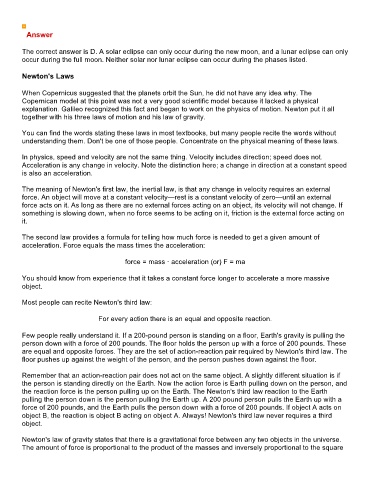Page 323 - ABCTE Study Guide_Neat
P. 323
Answer
The correct answer is D. A solar eclipse can only occur during the new moon, and a lunar eclipse can only
occur during the full moon. Neither solar nor lunar eclipse can occur during the phases listed.
Newton's Laws
When Copernicus suggested that the planets orbit the Sun, he did not have any idea why. The
Copernican model at this point was not a very good scientific model because it lacked a physical
explanation. Galileo recognized this fact and began to work on the physics of motion. Newton put it all
together with his three laws of motion and his law of gravity.
You can find the words stating these laws in most textbooks, but many people recite the words without
understanding them. Don't be one of those people. Concentrate on the physical meaning of these laws.
In physics, speed and velocity are not the same thing. Velocity includes direction; speed does not.
Acceleration is any change in velocity. Note the distinction here; a change in direction at a constant speed
is also an acceleration.
The meaning of Newton's first law, the inertial law, is that any change in velocity requires an external
force. An object will move at a constant velocity—rest is a constant velocity of zero—until an external
force acts on it. As long as there are no external forces acting on an object, its velocity will not change. If
something is slowing down, when no force seems to be acting on it, friction is the external force acting on
it.
The second law provides a formula for telling how much force is needed to get a given amount of
acceleration. Force equals the mass times the acceleration:
force = mass · acceleration (or) F = ma
You should know from experience that it takes a constant force longer to accelerate a more massive
object.
Most people can recite Newton's third law:
For every action there is an equal and opposite reaction.
Few people really understand it. If a 200-pound person is standing on a floor, Earth's gravity is pulling the
person down with a force of 200 pounds. The floor holds the person up with a force of 200 pounds. These
are equal and opposite forces. They are the set of action-reaction pair required by Newton's third law. The
floor pushes up against the weight of the person, and the person pushes down against the floor.
Remember that an action-reaction pair does not act on the same object. A slightly different situation is if
the person is standing directly on the Earth. Now the action force is Earth pulling down on the person, and
the reaction force is the person pulling up on the Earth. The Newton's third law reaction to the Earth
pulling the person down is the person pulling the Earth up. A 200 pound person pulls the Earth up with a
force of 200 pounds, and the Earth pulls the person down with a force of 200 pounds. If object A acts on
object B, the reaction is object B acting on object A. Always! Newton's third law never requires a third
object.
Newton's law of gravity states that there is a gravitational force between any two objects in the universe.
The amount of force is proportional to the product of the masses and inversely proportional to the square

